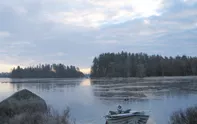Multistressors
Managing Multiple Stressors in the Baltic Sea
The project “Managing Multiple Stressors in the Baltic Sea”, is a Strong Research Environment funded by the Swedish Research Council for the Environment (FORMAS). We have assembled a diverse group from different departments at Lund University to combine paleo-based approaches, ecological approaches, terrestrial and aquatic biogeochemistry, and modeling to address problems from the past, the present and the future. Our goal is to provide the multi-disciplinary expertise needed for the sustainable management of the Baltic Sea.
Historical and present conditions
We have focused the work to three different coastal regions, Karlskrona archipelago, Gåsfjärden south of Västervik, and Umeå archipelago and we use the sediment records from lakes and the coastal areas as environmental archives.
Working themes
Coastal areas of the Baltic Sea
We use a combination of geobiological, sedimentological and geochemical indicators from both the surface water and the benthic environment:
- to study variations in nutrient status and bottom water oxygenation and
- to separate between natural variability in nutrient status and human induced changes.
We study the presence of biological remnants, such as foraminifera, dinoflagellate cysts and testate amoebas in sediment cores to be able to reconstruct temperature, salinity and other environmental factors. We also analyze the biogeochemical composition of the sediment and if there are pigments that derive from cyanobacteria. In this way we can get an idea of the anthropogenic impact on the Baltic Sea the last 2,000 years.
- Helena Filipsson (foraminifera)
- Wenxin Ning (dinoflagellate cysts)
- Anupam Ghosh (testate amoebas, foraminifera)
- Caroline Slomp (biogeochemical composition), Utrecht university
- Carolina Funkey (pigments from cyanobacteria)
- Svante Björck (development of the Baltic Sea)
- Daniel Conley
Modelling
We are also looking for long-term trends in hypoxia in the waters using BED (Baltic Environmental Database) series. Oxygen, nutrients, temperature and salinity are being considered and included in models to get a more realistic view of the development of the system and its current state. All this is done by combining different time series, statistical methods and programming tools. The expected results may highlight the present situation of the health of the the coastal Baltic Sea from a biogeochemical point of view, and this will help to address future possible management decisions.
- Angela Caballero-Alfonso (coastal hypoxia)
- Jacob Carstensen (coastal hypoxia)
- Daniel Conley (coastal hypoxia)
Landcover
Based on pollen diagrams from lakes and bogs, the aim is to achieve quantitative estimates of past vegetation and land cover composition in the three focus areas for the last 2,000 years. Using both existing pollen records in the three regions and a new record from a large lake in the Gåsfjärden area, the regional vegetation composition will be reconstructed using the REVEALS model, which incorporates differences in pollen dispersal and the relative pollen productivity of different plant species.
Anne Birgitte Nielsen (reconstruction of landscape, REVEALS modelling)
Anna Broström (reconstruction of landscape, REVEALS modelling)
Land to sea couplings
One of the aims of this project is to better understand the possible impact of forest management practices under different future climate scenarios on surface waters and the Baltic Sea. For this purpose a hydrological modeling component will be developed for the biogeochemical model ForSAFE. This will allow a better understanding of the effect of forest ecosystem changes on the quality of runoff at the catchment level and the possible effects on coastal waters.
LPJ GUESS, a dynamic vegetation model, will be used to simulate the dynamics of vegetation cover and terrestrial carbon (stored in vegetation, litter and soil carbon pools) in Baltic Sea catchment during the late Holocene. The data from global land-use datasets (HYDE 3.1, ACLL KK11) for the Baltic Sea catchment and pollen based land cover reconstructions produced by the Multistressors project for some river catchments in Sweden will be used to prescribe the portion of anthropogenic land use. The potential terrestrial Dissolved Organic Carbon (DOC) production from soil carbon pools for the Baltic Sea catchment will be estimated.
- Cecilia Akselsson (ForSAFE modelling)
- Giuliana Zanchi (ForSAFE modelling)
- Ben Smith (LPJ GUESS modelling)
- Anneli Poska (LPJ GUESS modelling)
Dissolved organic material
In the global marine environment, generally only a few percent of the total dissolved organic matter (DOM) are thought to be terrestrially derived, but in the Baltic Sea up to 80 % of the total DOM is of terrestrial origin, and as such it has a much larger influence in the Baltic environment. How does the terrestrial environment affect the composition of DOM? How does the structure and reactivity of freshwater processed terrestrial DOM affect the Baltic Sea? The role of dissolved organic nitrogen (DON) on the development and extent of eutrophication-driven hypoxia and responses to global warming will also be investigated.
- Emma Kritzberg (Brownification, DOM in the Baltic)
- Heather Reader (terrestrially derived DOM composition)
- Martin Berggren (cycling of DOC)
- Bala Selvam (cycling of DOC)
- Raquel Vaquer Sunyer (DON, hypoxia)
